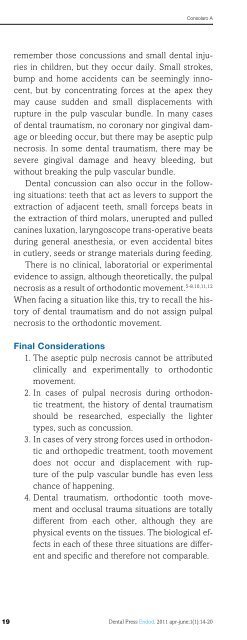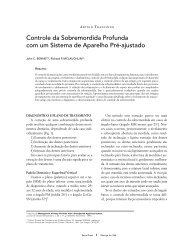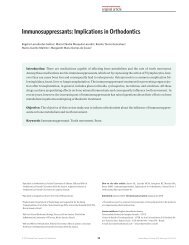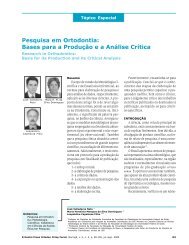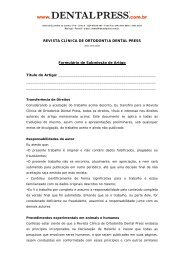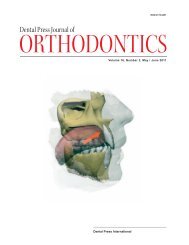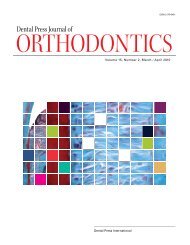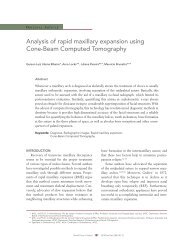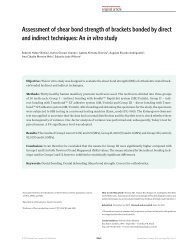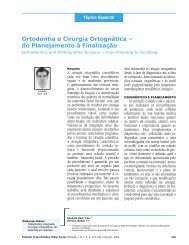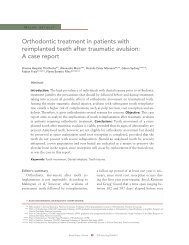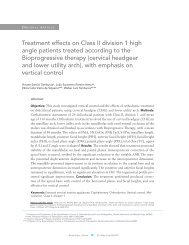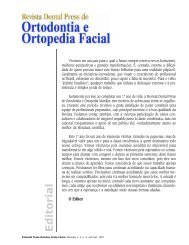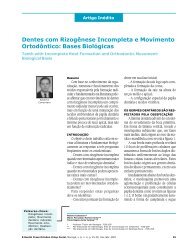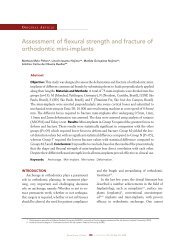Dental Press
Dental Press
Dental Press
Create successful ePaper yourself
Turn your PDF publications into a flip-book with our unique Google optimized e-Paper software.
Martinho FC, Cintra LTA, Zaia AA, Ferraz CCR, Almeida JFA, Gomes BPFAsamples were taken of the cavity surface and streakingit on blood agar plates. For the inclusion of the toothin the study, these control samples had to be negative.All subsequent procedures were performed aseptically.The pulp chamber were accessed with burs and rinsedwith sterile saline, which was aspirated with suction tips.The first root canal sample (s1) was taken as follows:five sterile paper points were placed for 1 minute periodinto each canal to the total length calculated from thepre-operative radiograph and then pooled in a steriletube containing 1 ml Viability Medium Göteborg Agar(VMGA III). Afterwards, the baseline samples (s1) weretransported to the laboratory within 15 minutes for microbiologicalprocedures.Clinical proceduresAfter accessing the pulp chamber and subsequent microbialsampling (s1), teeth were randomly divided intogroups according to the substances applied, as follows:I) saline solution (SSL) (n=11); II) natrosol gel (n=11);III) 2.5% NaOCl (n=11); IV) 2% CHX-gel (Endogel,Itapetininga, SP, Brazil) (n=11) and V) 2% CHX-solution(n=11). The pulp chamber was thoroughly cleanedwith substances from each group. A K-file size 10 or 15(Dentsply Maillefer, Ballaigues, Switzerland) was placedto the full length of the root canal calculated from thepre-operative radiographs. The coronal two-thirds ofeach canal was initially prepared using rotary files (GT ®rotary files size 20, 0.06 taper - Dentsply Maillefer, Ballaigues,Switzerland) at 350 rpm, 4 mm shorter than theestimated length. Gates-Glidden burs sizes 5, 4, 3 and 2(DYNA-FFDM, Bourges, France) were used in a crowndowntechnique reaching 6 mm shorter than the workinglength (1 mm from the radiographic apex). Afterwards,the working length was checked with a radiograph afterinserting a file in the canal to the estimated working length,confirmed by the apex locator (Novapex, Forum Technologies,Rishon le-Zion, Israel). The apical preparation wasperformed using K-files ranging from size 35-45, followedby a step back instrumentation, which ended after the useof three files larger than the last filed used for the apicalpreparation. The working time of the chemo-mechanicalprocedure was established at 20 minutes for all cases.In the CHX and natrosol gel groups, root canals wereirrigated with a syringe (27-gauge needle) containing 1ml of each substance before the use of each instrument,being immediately rinsed afterwards with 4 ml of salinesolution. Particulary, in NaOCl-group, the use of eachinstrument was followed by an irrigation of the canalwith 5 ml of 2.5% NaOCl solution. CHX activity was inactivatedwith 5 ml solution containing 5% Tween 80%and 0.07% (w/v) lecithin over a 1 min period. NaOClwas inactivated with 5 ml of sterile 5% sodium thiosulphateover a 1 min period. A second bacteriologicalsample was taken (s2), as previously described.After drying the canal with sterile paper points, allteeth were dressed with a thick mix of a paste of calciumhydroxide (Merck, Darmstad, Germany) with sterilesaline. The calcium hydroxide slurry was plugged in thecanals with a lentulo spiral. Radiographs were taken toensure proper placement of the calcium hydroxide inthe canal. The access cavity was restored with 2 mm ofCavit (3M <strong>Dental</strong> Products, St Paul, MN, USA) andFiltek Z250 (3M <strong>Dental</strong> Products), in order to preventcoronal microleakage. After 14 days, teeth were asepticallyaccessed under rubber dam isolation and the calciumhydroxide was removed by the use of the masterapical file and with sterile saline and careful filling thecanal with the master apical file. A third bacteriologicalsample (s3) was taken, as previously described.Culture techniqueThe transport medium containing the root canalsamplings was shaken thoroughly in a mixer inside ananaerobic chamber for 60 s (Vortex, Marconi, São Paulo,SP, Brazil). The transport medium contained glassbeads of 3 mm in diameter in order to facilitate mixingand homogenization of the sample prior to cultivation.Serial 10-fold dilutions were made up to 1:104 intubes containing Fastidious Anaerobe Broth (FAB, LabM, Bury, UK). Fifty µL of the serial dilutions 1:10 2 and10:10 4 were plated, using sterile plastic spreaders, into5% defibrinated sheep blood Fastidious Anaerobe Agar(FAA, Lab M), in which 1ml/l of hemin and 1ml/l ofvitamin K1 were added, so as to culture non-selectivelyobligate anaerobes. Plates were incubated anaerobically(80% N 2, 10% H 2, 10% CO 2) at 37 o C for 7 days(Peters LB 2002). Subsequently, 50 µL of each dilutionwere inoculated on BHI agar plates (Brain Heart Infusionagar, Oxoid, Basingstoke, UK), supplemented with5% sheep blood, and incubated aerobically (37º C, air)for 24 and 48 h. After incubation, the total CFU valuewas counted using a stereomicroscope at 16 x magnifications(Zeiss, Oberkoren, Germany).© 2011 <strong>Dental</strong> <strong>Press</strong> Endodontics 39<strong>Dental</strong> <strong>Press</strong> Endod. 2011 apr-june;1(1):37-45


